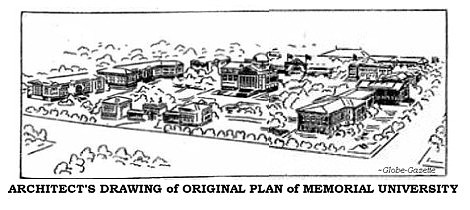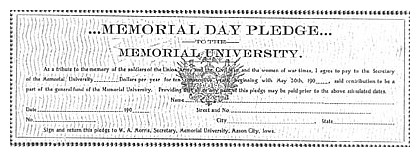


Cerro Gordo County Iowa
Part of the IaGenWeb Project
|
Mason City Mason Township, Cerro Gordo County, Iowa
Globe-Gazette, Mason City, Cerro Gordo County, Iowa

NOTE: Davenport Times, Davenport, Iowa, Wednesday, June 13, 1900. Adjutant General's Report ~ "Notes on Sons of Veterans": In the century of its existence Mason City has spent huge sums to provide the best possible school facilities, but Sorter's ambitious dream stands as the community's mightiest effort to achieve distinction in the field of education. Those who originated and launched the project were to have the heartbreaking experience of seeing their dream grow dim and fade away. Assisting Sorter, who was himself a member of the Sons of Union Veterans, were his father-in-law, H. E. Francisco, James E. Blythe, already recognized for his political organization work, and many others of the town's leading citizens. As soon as the Syracuse convention gave the "go" signal, incorporation papers were drawn up for the National Military College Association, with the following officers: J. E. E. Markley, president; Dr. T. T. Blaise, vice president; C. A. Dyer, secretary; and W. J. Reinke, treasurer.
The first action of the corporation was to purchase 160 acres south of the Milwaukee station. Forty acres were set aside for the university campus and the remainder divided into lots and sold. Architects drew plans for buildings on the campus, stressing "solitary grandeur and somber impressiveness rather than beauty." The college campus was to face north with a library and chapel in the center of numerous buildings. The library was to be in the shape of a Greek cross with a chapel in the rear.

On Sept. 20, 1902, the widely heralded Memorial University opened its doors to the youth of America. Then came shocking disappointment and the haunting fear that the fanfare had been for naught. Only 40 students were enrolled, a considerable number of them from Mason City. But Walter Doran, dean of the school, showed no pessimism when at the opening exercises he declared that the band of students before him "was small indeed compared to the thousands that will come." By the end of the first week hopes were renewed as some 100 students had arrived. When the expected influx of students failed to materialize, the Rev. S. S. Wyant, president of the university, spent most of his time traveling in search of students and, even more important, in quest of money.
When Wyant failed to show progress in operation of the school, the trustees hired another president, Frederick Tucker of Minneapolis. By this time the dream of the "Harvard of the West" and a campus full of buildings was fading. When Walter Patton was called from Wisconsin as president in 1906 he concentrated on raising funds, but found the interest of the Veterans organization was fast waning. Sectional differences played a part. Many of the members had wanted the school in the east. The Class of 1903 had seven graduates. The graduating class of 1909 was the last group of students to receive degrees from Memorial University. The 1909-10 term closed in midyear for lack of funds. That was the last of Memorial University. Al Sorter's fabulous dream had come to an end. When fire destroyed the high school (now [1953] the Lincoln school) in 1911, classes were moved to Memorial University. A few years later the Most Rev. James J. Keane, archbishop at Dubuque, bought the building and land for $180,000. In 1918 the Mason City school system purchased the property for $75,000 and converted the building into the Roosevelt grade school.

Transcription by Sharon R. Becker, December of 2014
|
Return to Cerro Gordo School Index Page Return to Cerro Gordo Home Page